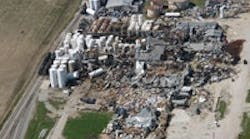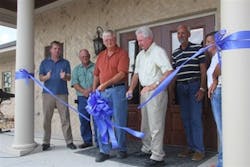Plant Rebounds After Natural Disaster
June 12, 2014
If a natural disaster hit your business, would you be prepared? How would you recover from the damage to your infrastructure?Unfortunately, we had to learn the real-life answers to these questions when, on April 24, 2010, a powerful tornado hit our chemical processing plant in Tallulah, La. A “tornado outbreak” — several tornados from the same weather system — ripped through four southern states, causing severe damage including multiple injuries and fatalities. When the tornado reached our plant, 14 employees were present. Luckily, nobody was seriously hurt (three people sustained minor injuries). However, the tornado devastated our entire 20-acre facility, as the lead photo shows. Our family-owned company, Complex Chemical Co., manufactures antifreeze, brake fluid and viscosity improvement additives for oil. It has been in operation since 1974 but never before had experienced anything like this catastrophe. Fortunately, between preparations we had made in advance and actions we quickly took after the event, the damage was minimized and recovery was relatively swift. Still, without a crystal ball, no company can prepare for every eventuality nor can it fully protect itself from the immense power of nature. In the wake of the tornado, we learned about the reality of recovery and the efficacy of the measures we had taken in advance to protect our business. STEP 1: ASSESS THE DAMAGEEvaluating the extent of the damage — with a particular focus on identifying safety issues — is the most pressing thing to be done in the early days after a disaster. Are there any immediate hazards? What can be fixed, as opposed to what must be replaced? What kind of cleanup must be done right away? How has transportation been affected? Three days after the tornado, we were able to take stock of the extensive damage to the facility. It was painfully apparent that all our warehouses and office areas were virtually destroyed. The electrical infrastructure also was wiped out completely, the piping system was damaged severely, and all communications were down. Three railcars were lying on their sides, with several others leaning and in danger of turning over as well. Seven storage tanks had toppled. Piles of twisted metal and other debris were scattered throughout the plant; several inches of spilled materials covered the containment areas, driveway and former building areas.
REBUILT PLANT
Figure 1. New facility includes a number of significant changes to improve efficiency and ease future expansion.
RIBBON CUTTING
Figure 2. The ceremony provided an opportunity to thank employees for their commitment and loyalty.
We felt that serving our customers definitely was worth the expense. Shortly after the tornado, we rented trailers to use as interim offices. To temporarily replace the destroyed warehouses, we brought in 20-ft × 40-ft containers for storage of raw materials and products. We rented 13 large generators and placed them strategically throughout the plant to power key areas — those with the most important pumps for moving product around, truck scales, the laboratory, and blending and distillation units. Communication lines were brought back up as soon as possible. Clearing driveways of debris right away was especially important — to allow us to make truck shipments. In the immediate aftermath of the tornado, we outsourced several areas of production including blending. In two weeks’ time, we were shipping our own inventory from before the tornado. Within a month, the main heater that serves our process areas was restarted successfully and we were able to begin simple blending to produce our own brake fluid. However, it was challenging because we had to keep our employees safe as they made product while debris removal and repairs were going on all around them. The next step was a rebuild of permanent structures including warehouses and offices. Building such structures requires drawing up plans and getting necessary permits, which can take a long time; so starting as early as possible is important. Checking building codes in the area before rebuilding also is a must — older structures and equipment may have been “grandfathered in” and, so, might have to be rebuilt differently to meet current codes.By June 14, less than two months after the tornado, all 11 of our processing units were operating successfully at 90% capacity and making product. Packaging and drumming were the only areas of production still being outsourced. However, the damage that had changed everything remained evident all around us: crews continued removing debris with barely an end in sight.STEP 4: FOCUS ON THE FUTUREDespite all these challenges, one bright spot after a calamity is the unique chance to make improvements. Rebuilding is an opportunity to start fresh where needed and possibly redesign some areas of the business to run better than before. What seems like a massive negative at the time actually can yield positive results. Think about space. We built a new, larger office building separate from the main plant, providing more room to handle the administrative side of the business while also leaving more space in the operations area of the facility. Several destroyed warehouses that had been used for storage of raw materials and finished goods were replaced with a single 100,000-ft2 structure. Storing everything in one place increased efficiency. Finally, brake fluid packaging lines, originally situated next to our oil blending areas, were moved to a new area to give both of these operations more room. Figure 1 shows the rebuilt site.Think about updating and making infrastructure more efficient. We had to replace the electrical system that had been demolished. The new system adheres to the latest codes and is more protected and better organized for future maintenance and expansion. We also rearranged some of the hard piping, pumps and other items related to the production process to make those operations more efficient and easier to run. A new, large steel enclosure to protect both the distillation and oil blending units includes a truck loading area, facilitating product transportation. Also to improve transport, we added more concrete to several key “traffic” areas. These extra slabs made loading and unloading operations run smoother and faster, speeding turnarounds. Think about revamping your product slate. During this period of change, we also decided to eliminate a marginally profitable product line, to allow greater focus on more-successful products. We found that our improvements helped to streamline our business and save money. Increased efficiency usually results in lower production cost while better space utilization gives more room to expand and at less cost. Our new and improved office allows us to get paperwork out quicker with less chance of mistakes. All of these changes likely have paid off already: our business has actually expanded since the storm. PREPARING FOR THE WORSTThroughout our ordeal, we found out which of the precautions we took before the tornado were helpful as well as how to best protect the company in the unlikely event of another disaster. For instance, we certainly learned a lot about the insurance claim process. It can be extremely time-consuming and possibly a sticky situation, right when you’re in the middle of dealing with the reality of a disaster’s effects on a business. And gathering the information needed to submit a claim takes more time than you might think.Look at your insurance before a disaster hits. First and foremost, have a qualified insurance consultant review your policy. You may think it’s adequate but “the devil is in the details.” For one thing, if your insurance is based on the cost of equipment bought a decade or more ago, it might not fully cover replacement with new equipment today. One unique challenge for a chemical facility is the containment of materials. After the tornado hit Complex Chemical, our team was happy to discover that no materials left the confines of the plant. Our spill prevention system consists of three elements: a concrete tier around the tanks themselves, an earthen levee that surrounds all the various tank sections, and a cut of the route water naturally uses to drain from the entire property. The system actually goes above and beyond current U.S. Environmental Protection Agency regulations — but we felt implementing a superior system was essential. We decided a long time ago that Complex would have responsible business practices in place to protect the environment around us. The system remains intact after the tornado; we continue to benefit from the peace of mind it brings. Finally, as part of our rebuild, we installed near our new office building a “bunker,” where we now keep important records and documents for safekeeping. If there’s enough warning time, our employees also will be able to take shelter there in an emergency. RELATIONSHIPS ARE EVERYTHINGWhen challenging events happen, as the old adage says, “you find out who your friends are.” Similarly, after a natural disaster, working relationships come into clear focus — and can be invaluable. A lot of our customers and even some competitors stepped up to help us in our time of need, and it really gave us a new understanding of the relationships we have in our business community. We truly believe that the good business relationships we’ve cultivated over the years have created a reciprocal feeling of goodwill that helped us during this challenging time. If you treat your customers how you would like them to treat you, and if you think of them as partners and not just as sources of revenue, we feel that — at least in some way — they will feel similarly. The tornado showed us the fruits of that philosophy.After an event like this, your customer base likely will show a wide variation in the level of understanding of and patience with what your company is going through, and management’s emotions are bound to be high. We found it important to step back and think about long-term relationships with colleagues before speaking or taking action during such a sensitive time. At the ribbon cutting to unveil our new-and-improved facility (Figure 2), one of us [Travis] spoke about the true heroes of the plant’s recovery — our employees. We’d like to share a bit of it:“The story of this rebuilding is theirs, the pages written with their blood, sweat and tears. They have demonstrated the finest qualities of the American worker and represented what has made this country so great. They never asked ‘how’ but simply ‘how soon?’” You can’t buy the kind of loyalty that was demonstrated by our employees; it only can be earned by being a good steward of the trust they have put in you. We’ve learned that employees who feel they are treated like family just might be the best kind of disaster recovery insurance there is.JERRY MELTON is president of Complex Chemical Co., Tallulah, La., TRAVIS MELTON is vice president of sales and marketing for Complex Chemical. E-mail them at [email protected] and [email protected].
Latest from Environmental Health & Safety
Latest from Environmental Health & Safety





